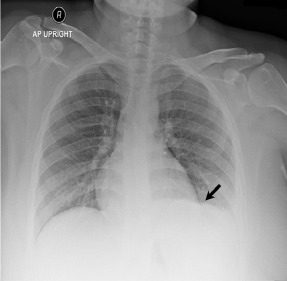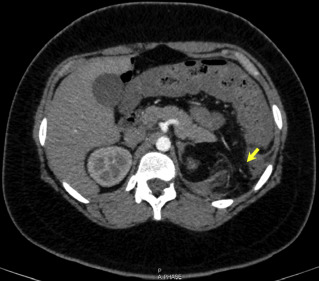A 21-year-old woman who had intermittent history of acid-related dyspeptic pain presented to the emergency department with 5 days of worsening colicky epigastric pain and occasional vomiting. The patient had been treated with oral antacid medications, without improvement. She had not experienced any traumatic event. Her physical examination showed normal vital signs but was pertinent for mild tenderness over the epigastric and left upper abdomen, without abnormal peritoneal signs. Chest radiograph revealed an elevation of the left hemidiaphragm ( Figure 1 ). Computed tomography (CT) of the abdomen was conducted to identify the subdiaphragmatic pathology.

Diagnosis
Pseudoelevation of left hemidiaphragm caused by colonic incarceration into a congenital diaphragmatic defect (Bochdalek hernia). The CT scan demonstrated a diaphragmatic defect at the posterolateral aspect of the left hemidiaphragm, consistent with a congenital Bochdalek hernia, with herniation of the splenic flexure colon and its mesenteric fat ( Figures 2 and 3 ). The patient was admitted to the hospital and underwent an urgent exploratory laparotomy with colonic reduction and closure of the diaphragmatic defect. The postoperative course was uneventful.






